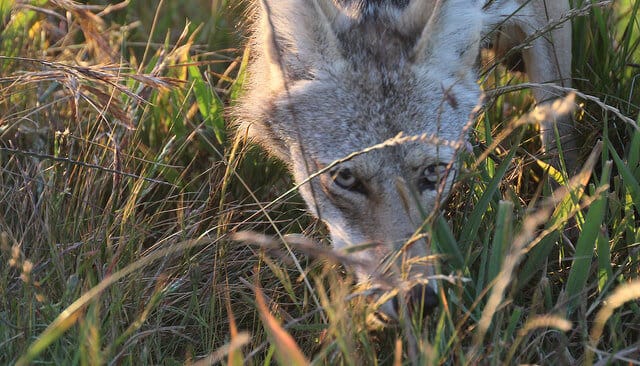By Jennifer Reed
Unfortunately for pet owners, coyote attacks are not an uncommon experience in San Diego.
Dr. Drake’s Jack Russell mix, Wilbur, suffered several puncture wounds to the head and shoulders a few years ago as a result of a coyote attack and sadly, many of our clients have also lost pets due to coyote-related incidents near their homes in recent months.
While coyotes have always been an important part of our local ecosystem—as predators, they play a vital role in keeping our rodent population at bay and, in turn, actually help preserve other populations of animals—their close proximity to our urban communities and their acclimation to human life makes them a serious threat to our pets.

Photo Credit: Mark Gunn
Incredibly intelligent and highly adaptable, coyotes have learned very quickly that our neighborhoods can make for good hunting ground. Keep your pets safe with these tips.
DO:
Be careful. Don’t let a lack of sightings fool you—coyotes are extremely common in Encinitas and surrounding areas such as Olivenhain, San Elijo Hills and Rancho Santa Fe, even in urban areas. Please be cautious with your pets at all times. Keep in mind that coyotes can attack any pet, but cats and small dogs are most at risk.
Check your fencing. Coyotes can easily leap over and dig below fences. Make sure your fence is at least six feet tall and extends at least one foot underground. Protective devices, such as Coyote Rollers, may also be installed on top of the fence to deter coyotes from climbing over.
Mix up the routine. Coyotes are opportunistic hunters. Try to avoid walking your pet at the same time every day or along the same route.
Keep pets vaccinated. Remember that coyote attacks are not the only danger these animals pose to our pets and our families. Coyotes can carry a number of diseases and parasites, including distemper, parvovirus and giardia.
DON’T:
Leave pets outside. Keep all animals indoors, especially at night, and never leave pets outside unattended. Be cautious with doggy doors as well. Do not leave doggy doors open when you are not home, even in the middle of the day. If you feed your pets outside, closely supervise them while eating and remove all food dishes promptly.
Forget the leash. Dogs should always be on a short leash when walked between dusk and dawn, when coyotes are most active. Whenever possible, walk in high pedestrian traffic areas and be careful to avoid bushy areas near trails and parks where coyotes may hide. Avoid using a retractable leash as it allows for too much distance between you and your pet.
Invite coyotes in. Do not leave anything in the yard that might attract coyotes to your property. This includes pet food, fallen fruit, bird feeders, open trash containers and compost piles. Even sources of water, such as fountains and fish ponds, can attract coyotes. Be sure to trim shrubbery in the yard to reduce hiding places and bring trash bins out the morning of pickup instead of the night before.
Suggested Articles:
First Aid for Pets: Preparing a Kit
Toxic Algae Blooms in California

